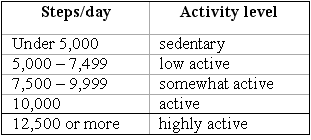How much exercise do I need to do?
New physical activity guidelines were released in 2011 in a report from the Chief Medical Officer.
Please click for more information on each age category:
- Physical activity should be encouraged from birth, particularly through floor-based play and water-based activities in safe environments.
- Children of pre-school age who are capable of walking unaided should be physically active daily for at least 180 minutes (3 hours), spread throughout the day.
- All under 5s should minimise the amount of time spent being sedentary (being restrained or sitting) for extended periods (except time spent sleeping).
- All children and young people should engage in moderate to vigorous intensity physical activity for at least 60 minutes and up to several hours every day.
- Vigorous intensity activities, including those that strengthen muscle and bone, should be incorporated at least three days a week.
- All children and young people should minimise the amount of time spent being sedentary (sitting) for extended periods.
- Adults should aim to be active daily. Over a week, activity should add up to at least 150 minutes (2½ hours) of moderate intensity activity in bouts of 10 minutes or more – one way to approach this is to do 30 minutes on at least 5 days a week.
- Alternatively, comparable benefits can be achieved through 75 minutes of vigorous intensity activity spread across the week or a combination of moderate and vigorous intensity activity.
- Adults should also undertake physical activity to improve muscle strength on at least two days a week.
- All adults should minimise the amount of time spent being sedentary (sitting) for extended periods.
- Older adults who participate in any amount of physical activity gain some health benefits, including maintenance of good physical and cognitive function. Some physical activity is better than none, and more physical activity provides greater health benefits.
- Older adults should aim to be active daily. Over a week, activity should add up to at least 150 minutes (2½ hours) of moderate intensity activity in bouts of 10 minutes or more – one way to approach this is to do 30 minutes on at least 5 days a week.
- For those who are already regularly active at moderate intensity, comparable benefits can be achieved through 75 minutes of vigorous intensity activity spread across the week or a combination of moderate and vigorous activity.
- Older adults should also undertake physical activity to improve muscle strength on at least two days a week.
- Older adults at risk of falls should incorporate physical activity to improve balance and co-ordination on at least two days a week.
- All older adults should minimise the amount of time spent being sedentary (sitting) for extended periods.
What about guidelines for people who are trying to lose weight or maintain weight loss?
Higher levels of activity might be needed.
- 45-60 minutes daily of moderate activity is recommended for people who want to avoid gaining any more weight.
- 60-90 minutes daily of moderate activity is recommended for people who want to actively lose weight.
Although these are the recommendations, it is important that you begin at a level that feels comfortable and safe for you.
Start with something that you find relatively easy and comfortable doing, no matter how small it may seem.
What is Moderate Activity?
'Moderate exercise' is not difficult. It is should raise your body temperature a little and leave you slightly out of breath, but you should still be able to hold a conversation with someone. This is a simple way of testing how intensely you are exercising, and is known as the talk test.
Moderate activity will vary depending on the person's fitness level. For example, walking a few yards might be moderate activity for someone who is very unfit, whereas someone else may need to briskly walk for 30 minutes.
Break up your activity
Fortunately, you don't need to do the whole lot at once to get the benefits. Instead, the time can be built up cumulatively over the course of the day, for example – in 10 minute bouts of activity.
Count your steps

Source: Tudor-Locke C, Bassett DR (2004)
Another popular way to determine your activity level is to count the amount of steps that you take in an average day. Pedometers are simple and inexpensive devices to count steps, attaching your belt.
Modern research says that taking 10,000 steps indicates an active lifestyle – so get stepping!
Remember that the benefits of exercise will diminish as soon as you stop doing it regularly. Think of it as a lifestyle change which needs to be maintained.
If you are worried about increasing your levels of physical activity we recommend that you speak to your doctor.
